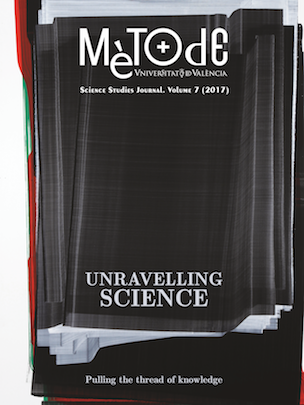A mysterious Universe: Revealing the bright and dark sides of the cosmos
DOI:
https://doi.org/10.7203/metode.7.8793Palabras clave:
cosmology, astrophysics, baryons, dark matter, dark energy Resumen
Resumen
Why is our universe as we observe it? Will it be the same forever? Understanding the nature of the main constituents of the universe is crucial to obtain a precise description of the way in which it reached its present state. Nowadays, many independent observations support a picture in which the matter content of the universe is shared between an ordinary and observable baryonic component (~5?%) and an invisible dark matter (~23?%). The remaining ~72?% of the universe content is in the form of a completely mysterious dark energy field. This composition emphasizes that, while ~95?% of our universe represents a major uncertainty for us, even the minor contribution from normal and, apparently, known matter entails important challenges for cosmologists.
 Descargas
Descargas
 Citas
Citas
Bull, P., Akrami, Y., Adamek, J., Baker, T., Bellini, E., Beltrán Jiménez, J., ... Winther, H. A. (2016). Beyond LCDM: Problems, solutions, and the road ahead. Physics of the Dark Universe, 12, 56–99. doi: 10.1016/j.dark.2016.02.001
Eckert, D., Jauzac, M., Shan, H., Kneib, J. P., Erben, T., Israel, H., ... Tchernin, C. (2015). Warm-hot baryons comprise 5-10 per cent of filaments in the cosmic web. Nature, 528, 105–107. doi: 10.1038/nature16058
Hamilton, J. Ch. (2013). What have we learned from observational cosmology? Studies in History and Philosophy of Science Part B: Studies in History and Philosophy of Modern Physics, 46(A), 70–85. doi: 10.1016/j.shpsb.2013.02.002
Hernández-Monteagudo, C., Ma, Y.-Z., Kitaura, F. S., Wang, W., Génova-Santos, R., Macías-Pérez, J., & Herranz, D. (2015). Evidence of the missing baryons from the kinematic Sunyaev-Zeldovich effect in Planck data. Physical Review Letters, 115(19). doi: 10.1103/PhysRevLett.115.191301
Moskowitz, C. (2016, April 11). Cosmic speed measurement suggests dark energy mystery. Scientific American. Retrieved from http://www.scientificamerican.com/article/cosmic-speed-measurement-suggests-dark-energy-mystery/
Olmo, G. J. (2012). Open questions in cosmology. Rijeka: InTech. doi: 10.5772/45746
Riess, A. G., Macri, L. M., Hoffmann, S. L., Scolnic, D., Casertano, S., Filippenko, A. V., ... Foley, R. J. (2016). A 2.4 % determination of the local value of the Hubble constant. The Astrophysical Journal, 826(1). doi: 10.3847/0004-637X/826/1/56
Descargas
Publicado
Cómo citar
-
Resumen1058
-
PDF 497
Número
Sección
Licencia
![]()
Todos los documentos incluidos en OJS son de acceso libre y propiedad de sus autores.
Los autores que publican en esta revista están de acuerdo con los siguientes términos:
- Los autores conservan los derechos de autor y garantizan a Metode Science Studies Journal el derecho a la primera publicación del trabajo, licenciado bajo una licencia de Creative Commons Reconocimiento-NoComercial-SinObraDerivada 4.0 Internacional, que permite a otros compartir el trabajo con un reconocimiento de la autoría del trabajo y citando la publicación inicial en esta revista.
- Se permite y se anima a los autores a difundir sus trabajos electrónicamente a través de páginas personales e institucionales (repositorios institucionales, páginas web personales o perfiles a redes profesionales o académicas) una vez publicado el trabajo.





